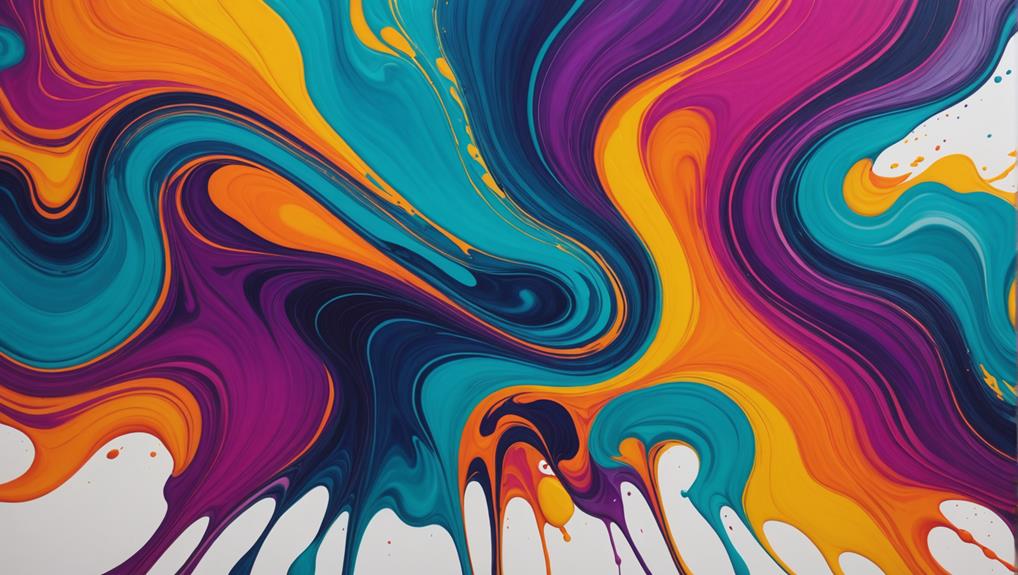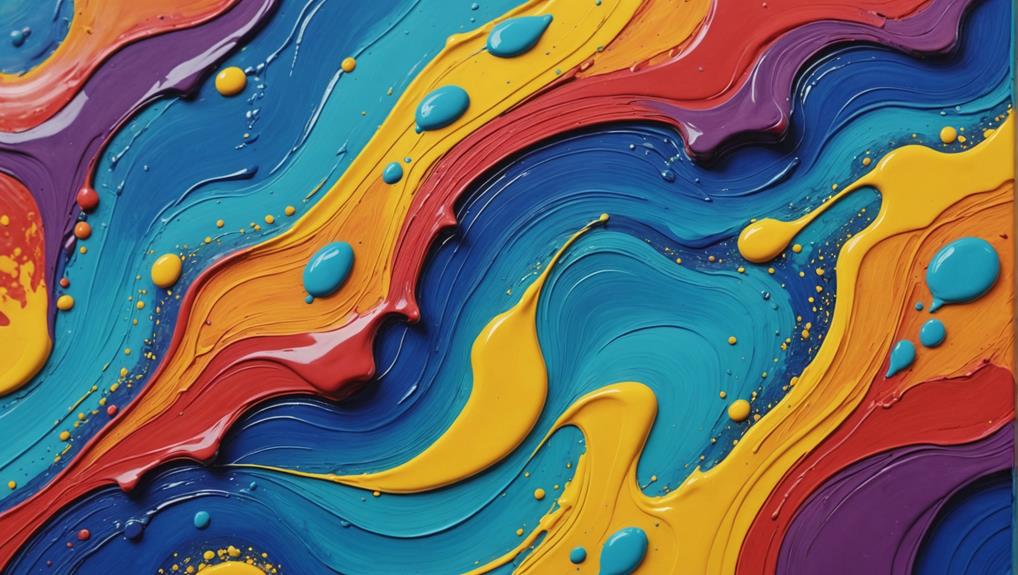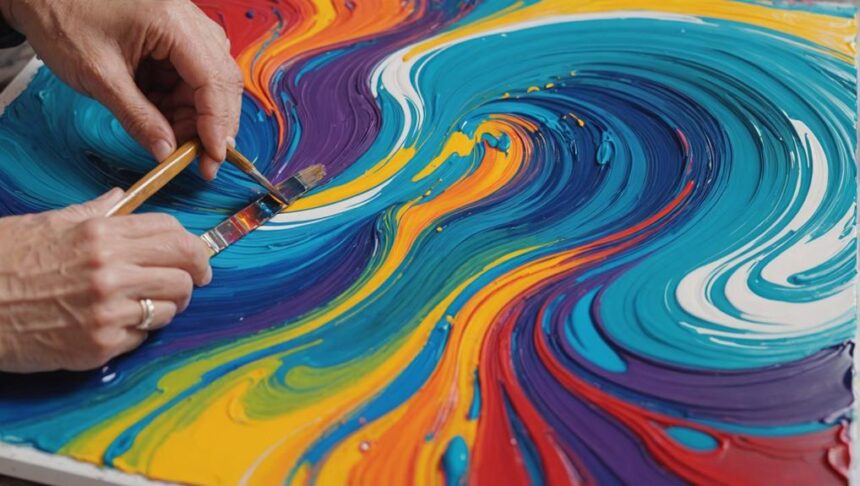Fixing composition mistakes in fluid art can feel like trying to save a sinking ship, but don’t worry—there are clever ways to recover your masterpiece. Start by addressing cracked paint areas; scraping them off and reapplying thicker layers helps. Color palette adjustments can work wonders, too—experiment with complementary hues for a vibrant effect. Proper canvas priming with gesso guarantees smooth layers and prevents further mishaps. Don’t forget to keep an eye on drying times to avoid any unwanted cracks. And for those tricky details, try lowering airbrush pressure. Curious about more ways to rescue your artwork? Keep exploring!
Key Takeaways
- Proper canvas priming with gesso ensures paint adhesion and prevents cracking.
- Scrape away cracked paint layers and reapply, allowing complete drying to avoid further issues.
- Use color harmony and complementary colors to enhance visual impact and correct color imbalances.
- Experiment with different blending tools like sponges and brushes for smoother transitions and textures.
Common Painting Challenges
A frequent challenge in fluid art is the improper preparation of base layers, which can lead to adhesion issues and potential cracking. Imagine spending hours on a beautiful piece, only to see it fall apart! This often happens because the base layers aren’t prepared right, especially when dealing with the tricky moisture in white acrylic paint. It’s like building a house on shaky ground—disaster is almost certain.
Understanding color theory is essential here. Think of it as the map to your masterpiece, guiding which colors mix well together and how they’ll interact over time.
But even the best colors can’t save you if the paint viscosity is off. In fluid art, thicker paint can cause your layers to crack as they dry, while thinner paint might run and mix unpredictably.
Correcting Airbrush Techniques
Correcting airbrush techniques in fluid art can feel like a challenging task, but a few key adjustments can make a big difference.
First, tweaking your airbrush settings for lower pressure and airflow gives you more control, allowing for finer details and smoother blends.
Also, remember that using precision tools, like sponges or even your fingers, can help enhance the effects and fix any mistakes, making your artwork truly stand out.
Adjusting Airbrush Settings
Mastering airbrush settings is vital for achieving precise and refined details in fluid art compositions. One of the first things to reflect on is airbrush maintenance. Regularly cleaning your airbrush and checking for clogs can prevent uneven paint application, which is a common headache for artists. Imagine working on a detailed piece, and suddenly, your airbrush starts to splatter—nightmare, right?
Pressure adjustments are another important aspect. Lowering the pressure allows for better control, especially when you’re working on those intricate details that can make or break your piece. It’s like driving a car; you wouldn’t floor the gas pedal in a tight parking lot. The same goes for airbrushing—lower pressure offers more finesse.
Airflow adjustments can also work wonders. By experimenting with different airflow settings, you can achieve various blending effects that enhance the depth and vibrancy of your colors.
And don’t forget about the paint itself. Thinner paint flows more smoothly through the airbrush, reducing the risk of clogging and unwanted textures.
Blending With Precision Tools
Building on the importance of fine-tuning airbrush settings, the next step involves using precision tools to enhance blending techniques and correct any airbrush mishaps. Imagine you’ve just sprayed a beautiful gradient, but there’s an awkward blotch ruining your masterpiece. Don’t panic! Precision tools like sponges and even your fingers can be your secret weapons.
First, let’s talk color theory. Knowing how colors mix can help you decide which shades to blend to fix that mishap. For instance, if you accidentally created a harsh line between blue and yellow, blending with a sponge can subtly mix the colors into a smoother green shift.
Now, onto texture techniques. Using a sponge can add soft, textured shifts between colors, making the painting look more natural. Thinner paint also helps, allowing for smoother, more controlled applications, and lower airbrush pressure prevents overspray, giving you better control.
Just remember, patience is key—let each layer dry completely before adding more paint to avoid cracking.
Priming Canvases Properly
Before you even think about pouring your paint, let’s talk about priming your canvas properly, because skipping this step can lead to some major headaches down the road.
Using the right primer, like gesso, guarantees that your paint sticks well and doesn’t crack or peel off later, which is especially important in fluid art.
Plus, letting the primer dry completely and testing a small area first can save you from a lot of frustration and wasted materials.
Correct Priming Techniques
Achieving a properly primed canvas is essential for guaranteeing that fluid art adheres well and maintains its integrity over time. One of the key steps in this process is the gesso application. Gesso acts as a primer that creates a smooth, even surface for your paint to stick to, which is particularly important for fluid art techniques.
When applying gesso, make sure to use thin, even layers. Allow each layer to dry completely before adding the next one, as this helps to avoid any issues like cracking or peeling later on.
Another important aspect to reflect upon is the canvas absorbency. A well-primed canvas should be able to handle fluid art techniques without soaking up too much paint. Testing your primed canvas with a small amount of paint can help you check for any adverse reactions before you engage in your main artwork. This step guarantees that your canvas is ready to handle the fluidity of the paint without compromising the quality of your art.
Lastly, regularly inspect your primed canvas for moisture or imperfections. These can greatly affect the final outcome of your fluid art piece, so catching them early is critical.
Avoiding Common Mistakes
Verifying your canvas is primed correctly can greatly reduce common issues encountered in fluid art, such as uneven absorption and paint cracking. Imagine spending hours perfecting your piece, only to see it ruined by cracks or blotchy patches! Properly priming sets the stage for success, much like preparing a good meal starts with fresh ingredients.
First, always use a primer designed for acrylic paints. This enhances adhesion and creates a smooth surface for your art. Think of it as laying a strong foundation for a house; without it, everything could collapse! Allow the primer to dry completely—patience is key here—to avoid complications with texture and adhesion later.
Before diving in, test the primer on a small canvas area to ascertain it gels well with your chosen paints. This small step can save a lot of heartache! Regularly inspect the primed surface for any moisture or imperfections. This attention to detail helps maintain the integrity of your color theory and composition balance, avoiding unwanted surprises.
Handling Cracked Paint Areas
Identifying the root cause of cracked paint areas is essential for effective repair in fluid art. Cracked paint can ruin the texture and overall appeal of your artwork, so knowing why it happened helps you fix it properly. Common reasons include moisture in the paint or not priming the canvas correctly.
Here’s how to tackle those pesky cracks:
- Scrape Away the Cracks: Use a palette knife to gently remove the cracked layers. This clears the surface for a fresh application of paint and guarantees a smoother finish.
- Apply a Thicker Paint Layer: When repainting, make sure the new layer is thicker. This helps prevent future cracks and improves the paint texture.
- Drying Time: Allow each layer of paint to dry completely before adding more. Rushing this step is a common mistake that can lead to cracking.
After scraping, use a soft brush or airbrush with lower pressure to apply the touch-up paint. This method guarantees a smooth finish and blends seamlessly with the existing layers.
Adjusting Color Palettes

When adjusting color palettes in fluid art, focusing on the strategic use of complementary colors can greatly enhance the visual impact of your composition. Embracing color harmony is essential for creating an enchanting piece. Complementary colors, like blue and orange or red and green, provide a striking contrast that catches the eye, making your artwork more dynamic.
Palette experimentation is vital in achieving the desired vibrancy and depth. Try different brands, such as Jo Sonja and Windsor and Newton, to see which paints give you the best results. Each brand has unique properties that can affect the final look of your piece. Don’t hesitate to mix and match!
Consistency in your color themes can also play a significant role. For instance, incorporating various shades of blue and violet can unify your artwork, giving it a cohesive and harmonious feel. Additionally, using thinner paints can offer better control and smoother shifts between colors, enhancing the overall effect.
Before diving in, always test your color mixes on a separate surface. This allows you to see how they interact and blend, ensuring they meet your expectations before committing to your canvas. This step can prevent unexpected surprises and keep your work on track.
Utilizing Blending Tools
In fluid art, utilizing blending tools such as fingers, sponges, and soft brushes is essential for achieving smooth color shifts and enhancing the overall composition. These tools allow artists to seamlessly shift between colors, creating a cohesive and visually appealing piece.
Here are three tools and techniques you might consider:
- Fingers: Blending with fingers offers direct control, perfect for manipulating smaller areas. This method is particularly effective when you want to create subtle texture effects, as the warmth and pressure from your fingers can alter the paint’s consistency.
- Sponges: Using a sponge provides a controlled application of paint, ideal for softening edges and creating a smoother finish. A damp sponge can yield softer, more delicate shifts, while a dry sponge can add interesting texture effects to your piece.
- Soft Brushes: Soft brushes are versatile blending tools that can be used to create a variety of effects. They are excellent for larger areas where a smooth gradient is desired. Adjusting the pressure and angle of the brush can produce different blending techniques, from feathering to stippling.
Experimenting with these tools can lead to unique outcomes, encouraging artists to refine their compositions and explore new creative possibilities.
Ensuring Smooth Paint Layers

Achieving smooth paint layers in fluid art requires meticulous attention to drying times, paint consistency, and surface preparation. Confirming that each layer dries completely before adding the next is essential; it prevents cracking and uneven surfaces that can ruin your masterpiece. Imagine the frustration of seeing your hard work marred by unsightly textures!
Paint viscosity plays a huge role too. Thinner paint, especially when used with an airbrush, offers better control and smoother application. Lower pressure settings on the airbrush can also enhance this effect, making your layers blend seamlessly. It’s a bit like finding the perfect balance in a recipe; too thick, and it won’t spread nicely, too thin, and it may drip everywhere.
Don’t forget the importance of priming your canvas properly. An unprimed or poorly primed surface can lead to texture issues, making smooth layers nearly impossible. Think of it as laying a good foundation for a house; without it, the structure is unstable.
Lastly, always check for moisture in your acrylic paints before you start. Moisture can cause cracking and disrupt the uniformity of your layers. By paying attention to these details, you can confirm your fluid art remains smooth and stunning.
Planning Future Projects
Strategic foresight is essential in planning future fluid art projects to avoid common composition mistakes and achieve a harmonious final piece. By thoughtfully considering your composition strategies, you can enhance visual balance and create stunning artwork.
First, sketch preliminary layouts. This helps identify potential mistakes before you even touch the paint. A simple sketch can reveal imbalances and allow you to tweak your design for better visual flow.
Second, choose your color palette wisely. Using contrasting and complementary colors can make your artwork pop and prevent it from looking muddy. Keep in mind that colors dry differently, so think about how they will interact once they’re on the canvas.
Third, respect drying times. Layers that aren’t fully dried can lead to cracking and unwanted textures. Patience is key; give each layer the time it needs to set before moving on to the next.
Here’s a quick list to keep in mind:
- Sketch Preliminary Layouts: Identify potential mistakes early.
- Choose Your Color Palette: Use contrasting and complementary colors.
- Respect Drying Times: Prevent cracking and texture issues.
Frequently Asked Questions
How to Fix Painting Mistakes on Canvas?
To fix painting mistakes on canvas, employ scraping and layering techniques. Make certain the canvas is dry before repainting, use thicker paint for repairs, and focus on color balancing to maintain visual harmony and depth in the composition.
How to Cover up a Painting Mistake?
To cover up a painting mistake, employ creative solutions such as paint layering techniques. Scrape off the problematic layer, apply a thicker base coat, and guarantee complete drying. Seamlessly blend new paint for a polished finish.
What Causes Lacing in Acrylic Pouring?
Lacing effects in acrylic pouring occur due to the interplay of differing paint densities, the use of silicone oil or additives, and environmental factors like temperature and humidity, which influence paint separation and fluidity.
How to Fix Pour Paint?
To fix pour paint, utilize pour techniques such as using a small brush for touch-ups, applying thicker layers to address cracks, and employing a heat gun for color blending to achieve seamless changes and enhanced depth.
Conclusion
In summary, mastering fluid art requires addressing common challenges such as airbrush techniques, canvas priming, and handling cracked paint.
Adjusting color palettes, blending tools, and ensuring smooth paint layers are essential.
These steps not only correct mistakes but also enhance the overall composition and quality of the artwork.
By planning future projects with these considerations in mind, artists can achieve more consistent and visually appealing results, thereby elevating their craft to new heights.


Leave a Reply